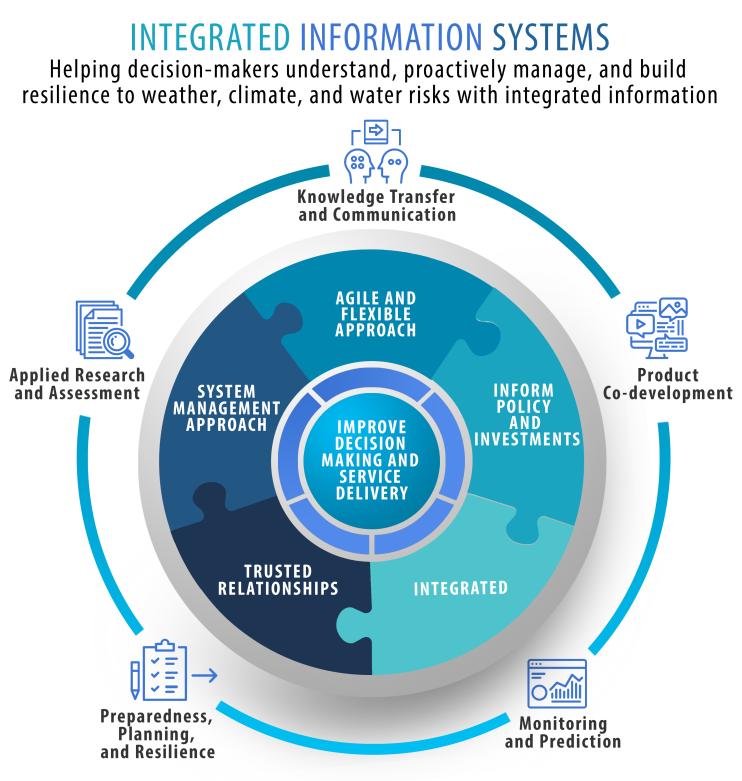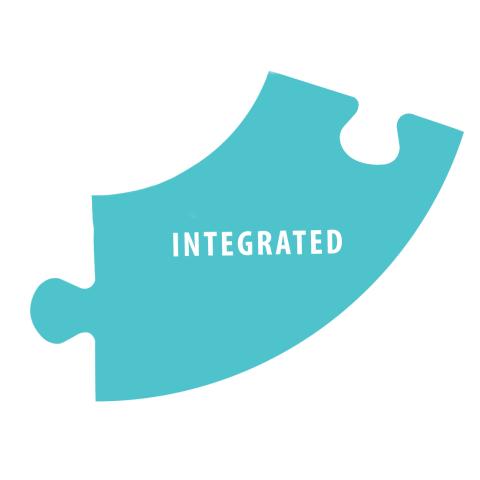For the latest forecasts and critical weather information, visit weather.gov.
Integrated Information Systems
Helping decision-makers understand, proactively manage, and build resilience to weather, climate, and water risks with integrated information.
What Is an Integrated Information System (IIS)?
An Integrated Information System (IIS) is a proven, whole-of-government organizational approach for enabling and strengthening capabilities to understand, manage, and mitigate societal risks from complex environmental hazards (e.g., heat, drought, floods). An IIS is designed to inform and improve the policy and decision-making landscape, connect and amplify existing programs and networks, and respond to emerging priorities in a rapidly changing climate.
Improving decision-making and service delivery is at the core of everything that an IIS does. An IIS adds unique value through convening, integrating, and strengthening existing individual efforts—such as a specific data portal, a community of practice or learning network, federal research programs, early warning systems—in the context of a defined problem and hazard. In essence, an IIS serves as a ‘network of networks’ that connects and amplifies existing work, while also addressing specific gaps identified by partners.
Three Integrated Information Systems currently exist, led by NOAA but implemented closely with partners at national, tribal, regional, state, and local levels. The National Integrated Drought Information System (NIDIS) initiated the IIS approach in 2006 to address drought. The IIS approach was adopted in 2015 as a model for the National Integrated Heat Health Information System (NIHHIS). The National Integrated Flood Information System (NIFIS) was established by the 2022 FLOODS Act.

How Do Integrated Information Systems Work?
All Integrated Information Systems incorporate and align five interconnected characteristics regardless of the environmental hazard and associated problems being addressed.
These can be thought of as puzzle pieces, with each piece required to complete the puzzle and provide an efficient implementation of an IIS:
- Agile and flexible approach to problem solving and new needs.
- Inform policy at the national and local levels.
- Integrated information across all existing elements.
- Trusted relationships across individuals, organizations, and disciplines.
- A Systems Management Approach to coordinate, support, and monitor actions undertaken by the IIS.

Agile and Flexible Approach
Agility and flexibility are key characteristics of an IIS, where each IIS is able to shift priorities to respond to the most pressing (and sometimes unanticipated) needs, as the hazard itself and users' priorities may change over time. Additionally, there is no single best approach for applying knowledge to resolving problems. For example, NIDIS utilizes a regional-based approach because solutions can often be shared between states.

Inform Policy and Investments
Each IIS has a key role in working with decision-makers and practitioners to inform action at all levels of governance. An IIS works to communicate the issues to the public, decision-makers, and other stakeholders in a way that supports action. To do this, the IIS maintains sustained engagement with policymakers at the national level through Congressional briefings and hearings. At the local level, the IIS works alongside partners to improve current policies to manage risk.

Integrated Information
An IIS is developed and executed intentionally to bring information and people together and to foster integration of existing efforts and networks to address specific problems. This includes the integration of scientific information and knowledge, such as models and data, into decision support tools. For example, NIDIS collaborated with USDA to convene service providers, decision-makers, and researchers on the issue of drought in a changing climate. The outcomes from this dialogue are resulting in the design of research investments that will inform near-term drought monitoring and long-term risk assessment. An IIS can also collate and curate the breadth of data and tools available in the context of a specific hazard context, such as through heat.gov and drought.gov.

Trusted Relationships
Relationships are critical to each IIS because the system relies on partnerships for its success. While the three existing Integrated Information Systems are NOAA-led, they take an interagency, organizational approach focused on working with decision-makers, researchers, stakeholders, and the public to learn from each other to define and address problems and promote resilience. For example, NIHHIS and partners have developed and run Extreme Heat Tabletop Exercises in cities across the U.S. to stress test plans and identify gaps.

A Systems Management Approach
An IIS builds and maintains partnerships, connects and integrates the existing networks and efforts underway, and provides the science community with user needs. This requires ‘care and feeding’ at a higher level than just an individual project. Therefore, a ‘systems’ approach is used by the IIS program offices to oversee the broader IIS strategy and implementation. For example, NIDIS supports a coordinator for each of the regional drought early warning systems (DEWS) who is responsible for convening regional partners and connecting tools and services from federal and state partners.

